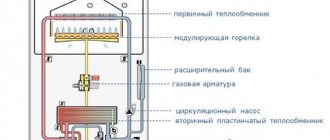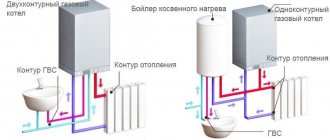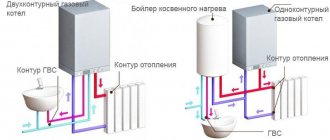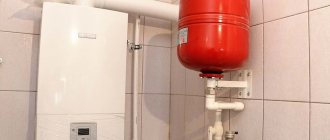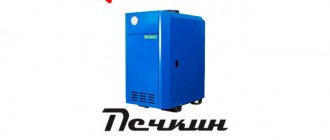Relatives bought a small two-story apartment with autonomous heating using a gas double-circuit boiler. An electric boiler was recently installed. Physically, I don’t understand why, a double-boiler boiler heats hot water. Please explain why an electric boiler is installed in the system.
An electric boiler is installed in addition to the existing gas heating device for:
1 Have an additional source of hot water supply (DHW) What is useful if you have to pay for gas according to consumption categories (to avoid gas consumption in the summer so that at the end of the year you will remain in a lower consumption category, with a lower cost per cubic meter of gas)
2 Have a reserve of hot water so that during peak water consumption there will be no “beating” of the hot water temperature
(a double-circuit boiler is capable of producing a limited amount of hot water per unit of time
maximum 12 liters per minute) That is, when someone takes a shower, and at this time in the kitchen they begin to wash the dishes, the person taking the shower receives less warm water on his back, but if there are several sanitary facilities, then everything can be more regular and more fun.
The boiler contains a supply of water heated to a given temperature and this allows you to smooth out temperature fluctuations.
3 The boiler also allows you to organize recirculation of hot water.
We used to heat ourselves with coal-stove heating, and heat the water with an electric boiler. When the gas was installed, I did not dismantle the boiler for reasons: “maybe it will do.” And it really came in handy when the sensor on the boiler failed and it stopped heating water. While they were repairing it, they used hot water from the boiler for a week.
For the same reasons, I did not dismantle the stove, you never know what will happen.
The boiler can be connected to the system, also as a guarantee that in the event of a boiler breakdown, the system will not defrost.
Or maybe it’s just that your relatives found it easier to hang a boiler than to pull a line of hot water up.
It also happens that not all boilers are equipped with pumps powerful enough to raise water to the 2nd floor.
There are many options.
Maybe they use the boiler as an expander? I know a case where people had scanty pressure in the water supply and the boiler did not perceive this pressure to the workers, so it did not start. An acquaintance bought an electric boiler and connected it to the system - the boiler turns on, the coolant expanding creates operating pressure and the boiler starts. (I would, of course, in this case, prefer an expander and a pump, but there are so many opinions among us.)
The lineup
Let's start with the fact that there are two models that work using the same technology, but the boiler itself is located differently:
- Models with a free-standing boiler.
- With built-in reservoir.
First option
For this, a separate gas boiler and a separate boiler are purchased. Here it is very important to accurately correlate the boiler power with the volume of the container. It may happen that the performance of a gas boiler is not enough to heat the water inside the boiler to a certain temperature (often up to +60°C) in a short period of time. This means you will not receive either hot water or an efficient heating system. Why?
It's all about the principle of operation of wall-mounted or floor-standing gas boilers with a boiler. It turns out that the coolant, heating up inside the boiler, is redistributed as needed. If the temperature of water for household needs inside the boiler corresponds to the programmed indicator, then the coolant works for the heating system. As soon as the temperature becomes lower, it is immediately redistributed to the DHW system. That is, the supply of coolant to the heating system is immediately turned off. This means the temperature in the house becomes lower.
Floor-standing with boiler
Attention! The larger the boiler volume you choose, the higher the likelihood that when the coolant is redistributed, the temperature in the house will always be lower than necessary. That is why we already said above that it is necessary to accurately correlate two indicators: the power of the heating unit and the volume of the boiler.
Currently, manufacturers offer two options for this type of boiler:
- Single-circuit with a separate hot water tank.
- Dual-circuit.
In the first case, these are floor-standing gas boilers with high power. In the second, these are wall structures. And here the question arises, which one to choose? It all depends on how much area you have to heat. If this is an apartment or a small country house (dacha), then the second option. If this is a large private house, then only the first one. But keep in mind that each type has its own advantages and disadvantages.
With built-in boiler
For example, a double-circuit gas boiler with a boiler has a heat exchanger with a small cross-section, that is, with a small cross-section. This is a minus. In addition, salt and mud deposits quickly settle in them, which means they will have to be washed and purged more often. In addition, maintenance of a single-circuit boiler and the boiler itself is simpler; in fact, the consumer receives a kind of central network through which the coolant flows, used for both heating and domestic hot water.
Why connect a water heater to a double-circuit boiler?
In summer, the double-circuit boiler does not work to maintain the required temperature in the rooms.
It is switched to a special “summer” mode, in which only hot water supply works.
When a flow appears through the heat exchanger, the burner turns on.
Often, a characteristic pop is heard due to the ignition of gas in the combustion chamber.
Listening to these claps all day is below average pleasure, and it’s unnecessary stress for the boiler.
To solve this problem, a scheme for connecting a storage water heater to the hot water supply circuit of the boiler was invented.
A storage water heater acts as a battery in which hot water is stored.
Other options
We talked above about storage-type structures. That is, the water in the tank has a certain volume, which heats up. But there are also flow-type models on the market. In them, water is heated to a certain temperature as it moves through a special heat exchanger.
Typically, the heat exchanger is made of a material with high thermal conductivity and good corrosion resistance. Therefore, this unit is most often made of copper, aluminum or stainless steel. But their shape is coiled, because you have to install a heat exchanger of quite a long length in a small volume. And the longer it is, the more efficiently it heats the water. By the way, water heating gas boilers, which were already mentioned above, operate using this system.
Simple connection diagram
Connection diagram of a water heater to a gas boiler
Now let's move on to considering the diagram for connecting the water heater to the DHW circuit of the boiler.
So, look at the picture below:
Connecting a water heater to a gas boiler
The figure shows that the storage water heater is connected separately to the boiler and to consumers.
The separation is done using two three-way valves with servo drives.
Switching the servos and turning on the circulation pump is carried out by a device called a “power control circuit”.
This device is connected to the water heater thermostat. There are no standard solutions here and you will have to invent this device from scratch.
For comparison, I will give you another diagram from the technical document:
Connecting a double-circuit boiler to a water heater
There are no three-way valves and no power management circuitry in this circuit.
The circulation pump is powered directly through the water heater thermostat.
This is done according to the following scheme:
Electrical diagram for connecting a water heater
The upper diagram has one important feature - the water heater there has three connection pipes.
This is a non-standard option for electric water heaters, but indirect heating boilers have a recirculation input and output, through which it is quite possible to organize a similar connection scheme.
Well, for ordinary electric water heaters we will again have to invent something. Sometimes such a “collective farm” takes a lot of time, effort and money.
Now let's understand how water circulates in the upper circuit. To do this, I will give two more pictures:
Water heater connection diagram
Connecting an electric water heater
In the upper figures, arrows indicate the direction of water circulation in each operating mode.
In this scheme, heating and water withdrawal can occur simultaneously.
Advantages of single-circuit boilers with a boiler
So, we have established that single-circuit gas boilers with a separate boiler are considered the most popular today. Therefore, there is a need to outline all its advantages:
- Large internal cross-section of the heat exchanger. This helps reduce scale formation. Unfortunately, the quality of water used in domestic water supply systems leaves much to be desired.
- High reliability indicator, which is determined by the simplicity of the design of the device itself.
- In this model, the consumption of thermal energy is more rational, and, therefore, this is the reason for the high efficiency and savings in fuel consumption.
- The water inside the boiler almost always has a certain temperature. It is not affected by pressure surges inside the gas line or temperature surges inside the heating system of the house.
- Ease of maintenance, where it is necessary to note a minimum of automation devices.
- The entire set (gas boiler plus boiler) consistently provides hot water to your home, regardless of the time of day. In addition, the heating also works stably.
- Simple built-in automation will help you set the necessary parameters for hot water in the DHW system and coolant in the heating system. She also controls these parameters.
Indirect heating boiler - configurations
I know about a dozen configurations. I select it depending on what problem I need to solve.
I install an indirect heating boiler with one heat exchanger if I need to prepare hot water from a single energy source. This can be a solid fuel, electric or gas boiler with one circuit.
Tesy indirect heating boiler
I install boilers with two heat exchangers when there are two heat sources. For example, I installed a solid fuel boiler and solar collectors in a private house. Or, for example, an electric and solid fuel boiler. In this case, one heat source is connected to one boiler spiral, and the other source is connected to the second heat exchanger.
Tesy indirect heating water heater
Optimal operating mode of an electric boiler
Setting the temperature to the minimum permissible is highly not recommended for the following reasons:
- Reduced efficiency of water heating equipment;
- Liquid temperature 30-40⁰ C is an ideal environment for the formation and proliferation of bacteria and mold, which inevitably end up in the water;
- The rate of scale formation increases.
These devices are often equipped with an economy mode option, designated by the letter E. This operating mode means heating the liquid inside the capacitive tank to a temperature of +55⁰ C, which allows you to extend the period of use before maintenance. That is, at a given temperature regime, scale forms the slowest, and accordingly it is necessary to clean the heating element less often. This does not apply to energy savings.
Operating principle
The operation of a double-circuit boiler consists of two streams:
- The coolant enters the primary heat exchanger and receives the maximum possible temperature. It is then passed through a secondary heat exchanger, where it transfers some of the resulting energy to prepare hot water. After this, it passes into a three-way valve, receives the desired temperature by mixing some of the return flow, and is discharged into the heating circuit for a new circulation circle;
- cold water enters the boiler and is passed through a secondary heat exchanger. After that, it goes to the consumption devices. When the tap opens, water begins to pass through the plate device and heat up in flow mode. The more water is drawn, the lower the water temperature - at high flow rates it does not have time to heat up properly.
The coolant is prepared in the flame of a gas burner. For its operation, air is required, which is supplied by the turbocharger fan. Excess pressure arises, pushing the smoke out through a special coaxial chimney.
The operation of all system components is constantly monitored by self-diagnosis sensors.
They immediately signal the occurrence of failures or malfunctions, the control board places an alert on the display, and in some dangerous situations immediately turns off and locks the boiler.
NOTE!
Non-volatile models are equipped only with mechanical parts. They are much simpler and do not have fans, centrifugal pumps or control units. The functioning of the system occurs on the basis of natural processes of traction and lifting of warm layers of liquid upward.
Boiler installation
It is recommended to place the boiler in a place where it will not interfere, for example, above the toilet in the corner.
- Having determined the installation location of the boiler, you need to drill 2 holes in the wall, hammer 2 dowel nails into them and screw in the mounting brackets.
- The next thing that remains is the story of the boiler on the brackets.
- Crash into a plumbing system.
- Install a ball-type shut-off valve.
- Install a water purification filter with a cartridge.
Then a tee is installed, and a pipe is led from it to the cold water tap. Another pipe is led to the boiler simultaneously with the installation of the second shut-off valve. This pipe is connected to the overpressure valve, which is pre-installed on the boiler.
Two more taps, built into the boiler itself, are intended for preventive maintenance and draining water. The faucet for complete drainage began to be installed quite recently, and if you do not open it, then you will always have 80-100 liters of water in stock. But for the drain to work, both taps are needed to eliminate hydraulic plugs in the pipes.
The collet, which is connected to the hot water outlet pipe, serves to start distribution throughout the apartment. During pipe laying, holes are drilled for special mounting clips for pipes. The power cable is supplied in a separate line; grounding must be done. An electric boiler must be connected to voltage through a paired circuit breaker.
How to calculate power?
Calculating boiler power is too complex a task. An unprepared person cannot cope with it . However, there is a simple calculation option that gives an approximate, but quite acceptable result.
Heating 10 m2 of area requires 1 kW of thermal energy. Based on this ratio, you can quickly determine the required boiler power. For example, for a house of 200 sq.m. you need 20 kW of thermal energy.
A unit of either 18 or 24 kW is suitable.
NOTE!
You should not make a large power reserve, since the boiler begins to operate at minimum mode. Frequent starting and stopping of the burner contributes to the rapid failure of components, and scale accumulates in the heat exchanger. The result will be the need for expensive repairs or the purchase of a new boiler.
Most popular manufacturers
European companies are considered the most reliable and popular manufacturers.
These include:
- Vaillant;
- Viessmann;
- Navien;
- BAXI;
- Protherm;
- Buderus;
- Bosch, etc.
The list can be continued for a long time, but there is little point in listing the names of companies. on the market, offering their developments and models .
This allows you to choose the most suitable boiler with the required parameters.
